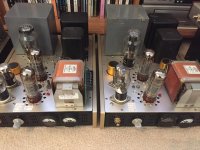Not much. I added the trim pot for the 6SN7's cathode CCS for minimize the THD. It works very well to maintain low level of THD.
Johnny
Johnny
That is NOT a Williamson. Modified or not. It is closer to a Mullard variation. Why not call it a Johnny design and avoid confusion?
I am glad to share my modified version of the EL34 or 807 PP amp. My friend and I built it and found it sounds so sweet and smooth like the Singled Ended one. I hope someone would have ideas for further improvement of the amp.
Johnny
We appreciate your work and effort but this is nowhere close to Williamson. The possible brand is Johnny's Mullard.
Johnny, can you explain the bias arrangement in the cathodes of the power tubes? I'm not sure I understand what you're doing there.
Why not have a B+ of between 400 - 425 volts, as was often done with 807s? Then, give it some NFB.
The power tubes are being biased for class A operation. The common cathode resistor works like a differential amp which balance the gain between the two power tubes. The bottom variable resistor is used for DC balance of the power tubes. A 1000uF bypass capacitor is used to avoid AC signal feedback to the grids. This arrangement reduce the THD in the power stage.
The B+ can be raised to 430V for higher power for sure. The reason I lower the B+ because I want it to use the 6A5 power tube which has maximum B+ of 350Vdc.
Johnny, can you explain the bias arrangement in the cathodes of the power tubes? I'm not sure I understand what you're doing there.
That's the classic Williamson balancing arrangement. By connecting the grid resistors to the 100 ohm pot, you can precisely balance the output tubes, which was considered critical for best low frequency performance and lowest distortion in the original Williamson design. Rather than adjust the cathode resistance, you're actually adjusting each grid's relationship to ground by a handful of volts. The grids are still negative with respect to the cathode, but if you measure grid-to-ground they actually measure positive by 4-6 volts. It's a clever design and is very stable.
Thanks for this discussion. I have some 807's and am always on the lookout for a good circuit.
People that use the 807 mention that it is prone to 'snivets' and needs plate stoppers on the top cap to prevent it oscillating ...
Miles Power discussing 807
Did you consider adding the suppressor circuit mentioned? It could be that using it as a pseudo-triode makes this less of a consideration.
People that use the 807 mention that it is prone to 'snivets' and needs plate stoppers on the top cap to prevent it oscillating ...
Miles Power discussing 807
Did you consider adding the suppressor circuit mentioned? It could be that using it as a pseudo-triode makes this less of a consideration.
In very high-voltage situations, like transmitting devices, the 807 needs some special care. In the Williamson design, with the plate voltage limited to 375-400VDC, it's never been cited as a concern, and I've never had a problem.
807's are lovely tubes, about the closes thing to a directly-heated 300B I've ever heard. There are lots of 807 designs out there, both PP and SE. I'm very partial to Williamson amps. Tim Robbins has an excellent Williamson resource page here:
Dalmura
The 807 can be used in just about any early Williamson design that calls for a 5881 or 6L6GC, up to about 1955 when designers started trying to pump more power out of the Williamson.
I use the "ultralinear" version of the famous Musican's Amplifier from 1950. The author's updated the amp in their "Gilding the Lily" article. These are both on Tim's list. Heyboer makes a really splendid copy of the Peerless S-265-Q that can be used to build an "original" Musician's Amplifier.
807's are lovely tubes, about the closes thing to a directly-heated 300B I've ever heard. There are lots of 807 designs out there, both PP and SE. I'm very partial to Williamson amps. Tim Robbins has an excellent Williamson resource page here:
Dalmura
The 807 can be used in just about any early Williamson design that calls for a 5881 or 6L6GC, up to about 1955 when designers started trying to pump more power out of the Williamson.
I use the "ultralinear" version of the famous Musican's Amplifier from 1950. The author's updated the amp in their "Gilding the Lily" article. These are both on Tim's list. Heyboer makes a really splendid copy of the Peerless S-265-Q that can be used to build an "original" Musician's Amplifier.
Last edited:
- Home
- Amplifiers
- Tubes / Valves
- Modified version of Williamson 807 or EL34 PP amplifier
